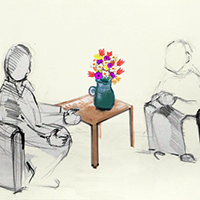Empathy as core to the development of holding and recognition: the case of Garret

All claims expressed in this article are solely those of the authors and do not necessarily represent those of their affiliated organizations, or those of the publisher, the editors and the reviewers. Any product that may be evaluated in this article or claim that may be made by its manufacturer is not guaranteed or endorsed by the publisher.
Authors
Heinz Kohut investigated empathy in psychoanalysis in the mid-1950s and found it to be a powerful way to connect to, and be with, his patients. Since then, relatively few recent clinical cases of empathy have emerged, while theoretical discussion of empathy seems to be the norm. Moreover, empathy has not been linked to the development of holding and recognition. The Winnicottian notion of the holding metaphor, which describes the mother holding her infant, has been controversial but continues to be used in therapy. Revised by relational theorists, holding is now viewed as co-created within the intersubjective space. Few recent clinical cases exist showing how and what holding looks like in therapy. The concept of recognition, also used in therapy, is defined as the ability to recognize and experience the other as a separate other. Clinical cases showing recognition in therapy are few in number. As far as I know, no clinical cases suggest that empathy is necessary before holding and recognition can emerge. In this paper, identifying these clinical case gaps in the literature, I describe a small verbatim section of a session with my patient, Garret, in which I attempt to; i) show the empathic process, thus adding to the scarcity of clinical cases, and, ii) show the experience of holding and recognition as they emerge in this case, and iii) suggest that empathy is a necessary core process to the development of the experience of holding and recognition.






